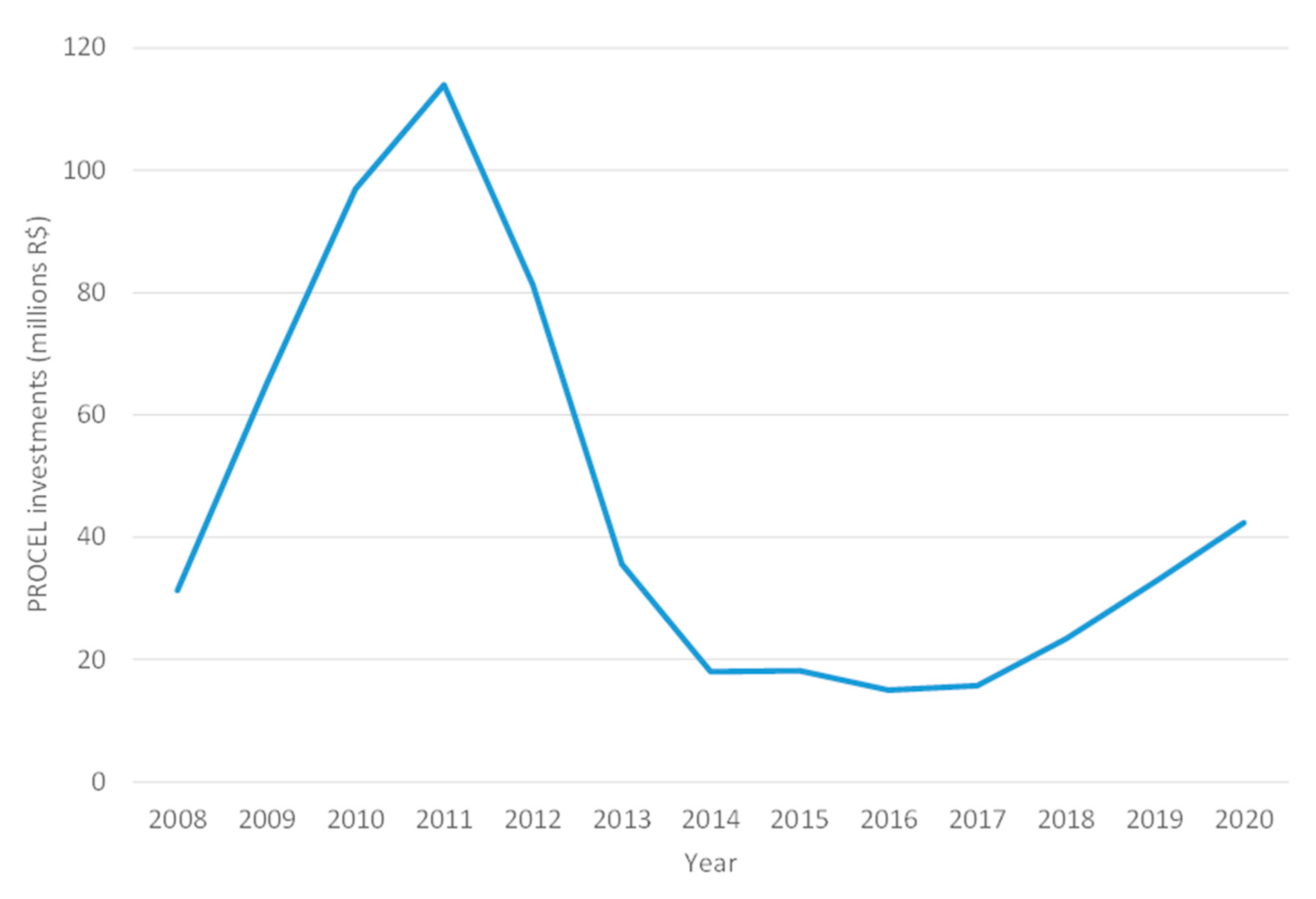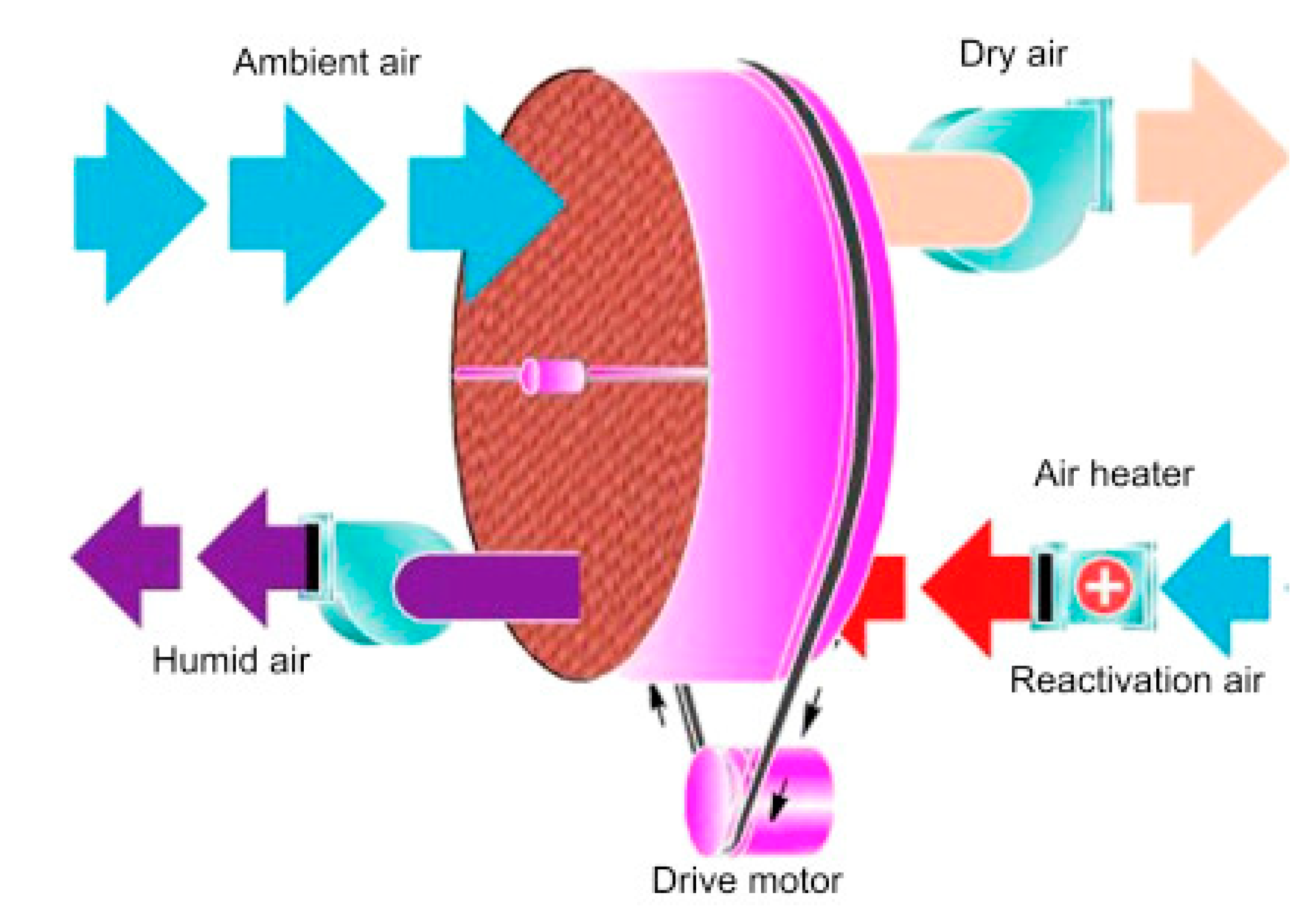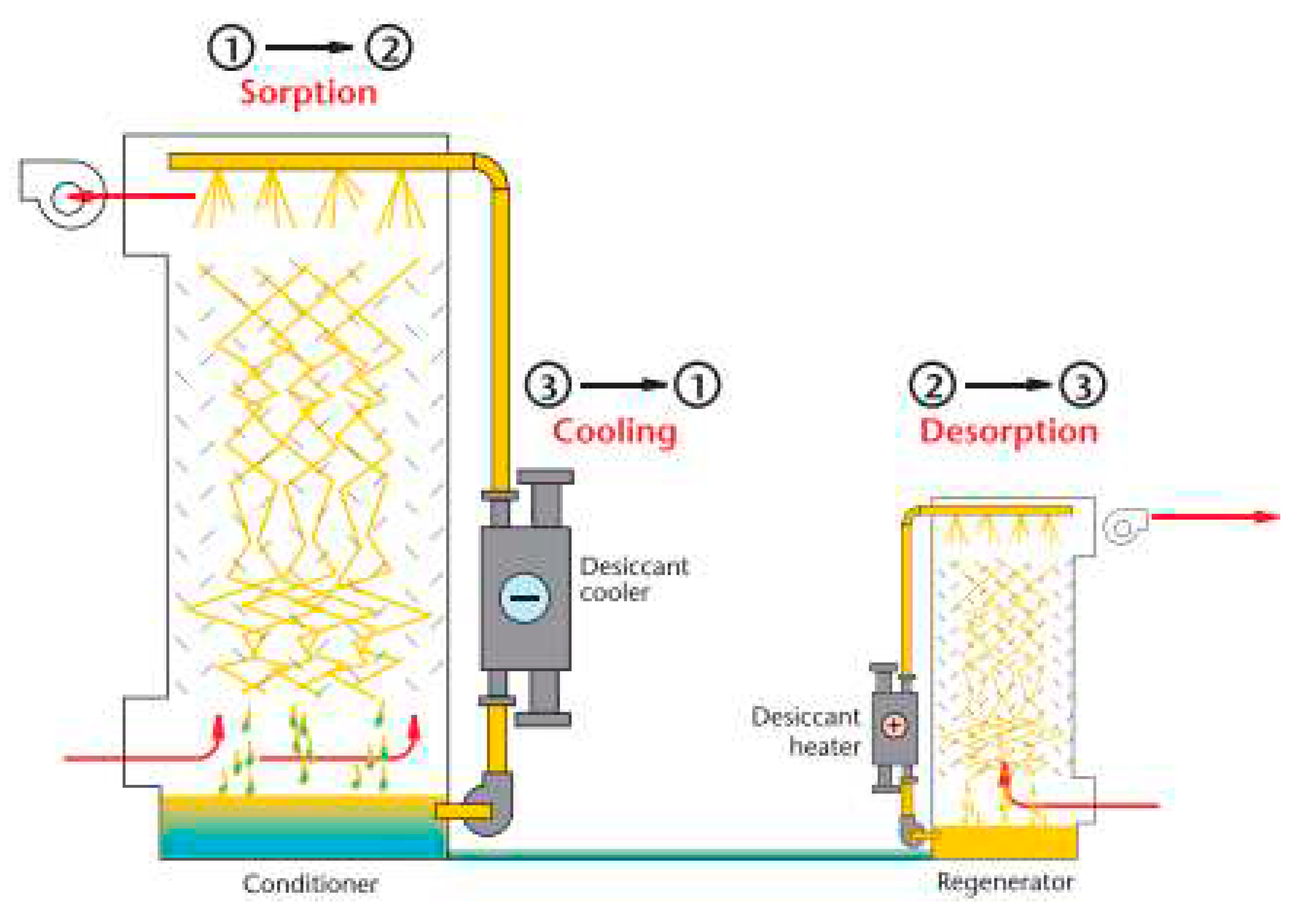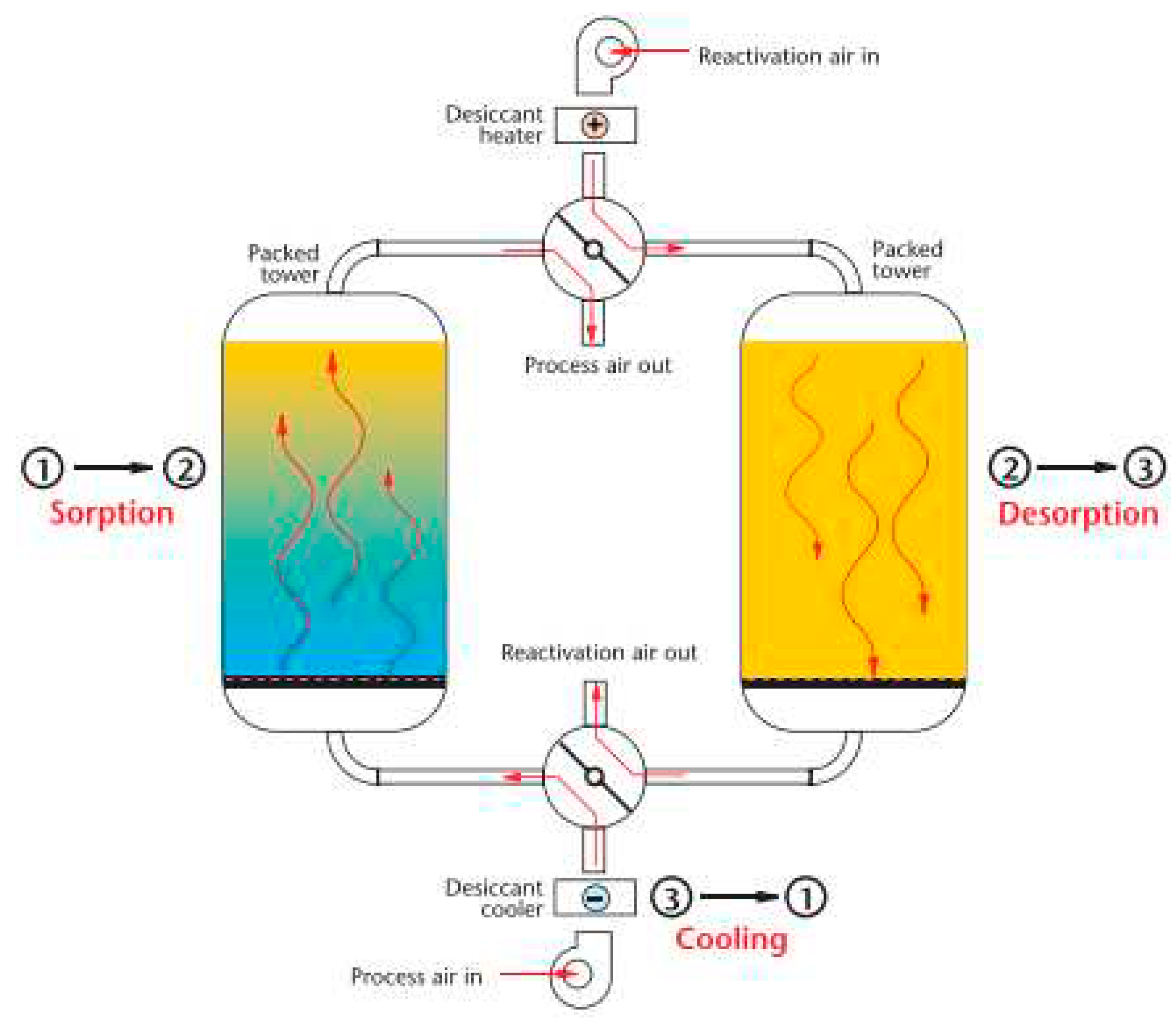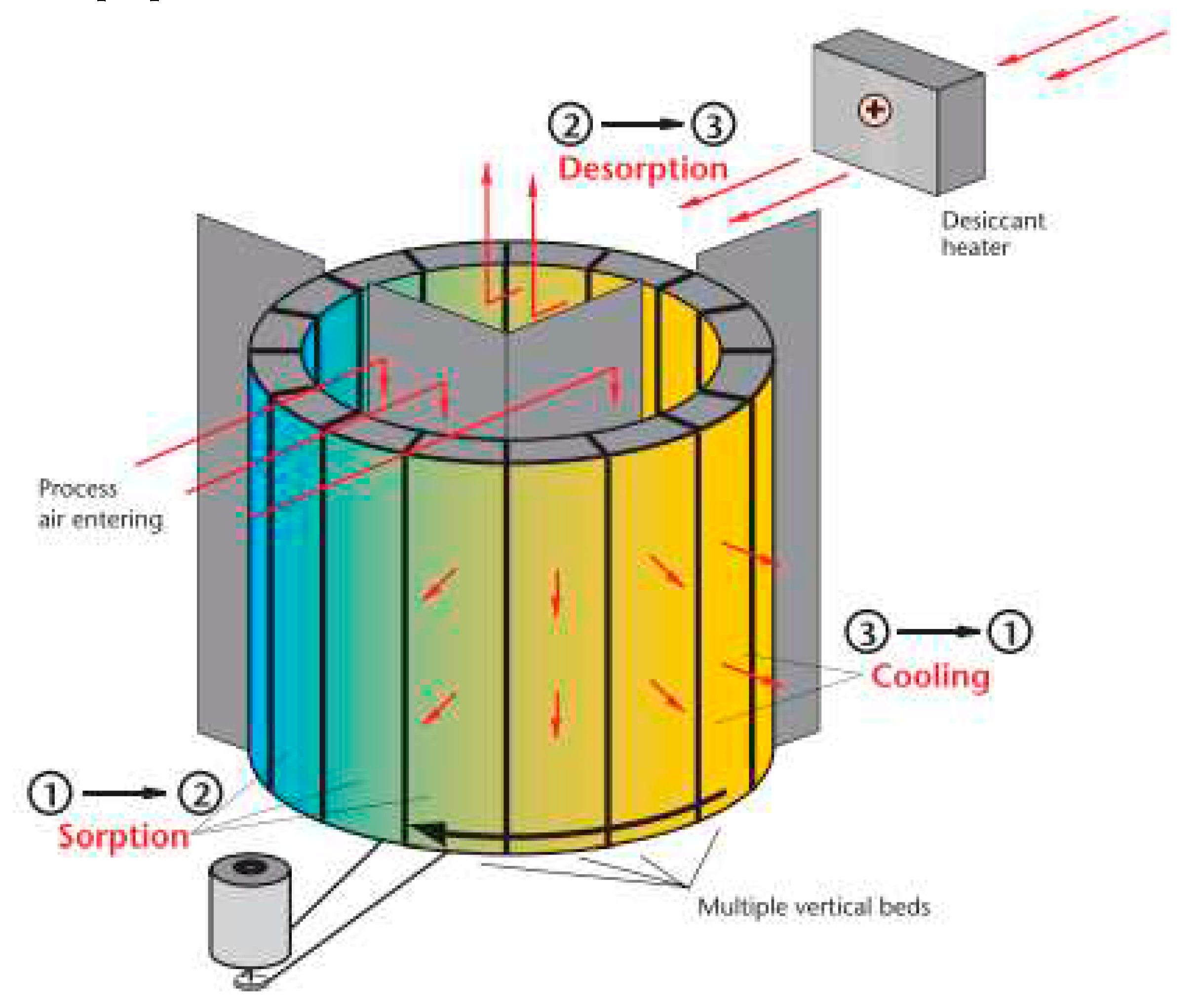1. Introduction
In air conditioning design, it is essential to consider the addition of external air to closed environments such as offices, schools, hospitals, malls, among others. The American Society for Heating, Refrigeration and Air Conditioning Engineering (ASHRAE) establishes that if a building has more than 20% of people with symptoms of some disease or discomfort when exposed to this environment, it is considered a building that fits a Sick Building Syndrome (SBS) situation [
1].
The lack of indoor air renewal causes the accumulation of chemical pollutants (carbon monoxide and dioxide, sulfur dioxide and formaldehyde, ammonia, among others) and biological contaminants (fungi, algae, protozoa, bacteria, and mites), which makes the air hazardous for human health, being a risk factor for people with respiratory diseases [
2]. Environments with high levels of these pollutants are conventionally called SBS, where the World Health Organization (WHO) recognized this problem in 1982 [
3].
In the 1970s, an energy crisis spread globally due to conflicts between oil exporting countries in the Middle East. As a result, oil suffered a reduction in production and a price increase, reaching 400% in 1973. In the same period, engineers, looking for alternatives to reduce the consumption of electric energy [
4], reduced the external air supply to buildings [
5,
6]. Consequently, the first reports of SBS [
7] were seen.
Fungal exposures are receiving increasing attention as an occupational and public health problem due to the high prevalence of fungal contamination in buildings [
8]. Moisture and moisture-related problems are significant sources of fungal contamination in homes, buildings, and schools [
9]. Indoor fungi can be inhaled, and the presence of such particles has been linked to many illnesses and symptoms (infections, allergic reactions, or toxic responses) among occupants of moisture-damaged buildings [
10]. On the other hand, moisture damage in buildings could alter various components of building materials, which can be another source of deterioration in indoor air quality (IAQ) [
11]. Fungal growth is associated with moisture content, defined as the ratio between the material’s free water and its dry weight [
12].
Some studies indicate a relation between humidity, indoor-measured visible biological contaminant growth, and its effects on human health. Sterling et al. [
13] analyzed the humidity impact on contaminants (such as viruses, bacteria, and fungi) and the possible impacts on human health. The authors observed, at room temperature, that the required humidity range for minimizing risks to human health by biological contaminants was between 40 and 60%, as shown in
Figure 1.
In 1984, the WHO estimated that up to 30% of buildings could be affected by SBS. In the early 1980s, the concept of SBS was correlated with environmental problems.
Table 1 shows some of the main symptoms associated with SBS. However, the concept evolves and includes psychological aspects, economic implications, energy savings, and climate change [
14].
Brasche [
15] observed that women suffer more from SBS when compared to men, with 44.3% of women suffering from SBS, while only 26.2% of men face this problem, as shown in
Table 2. However, this percentage difference between genders is due to position within the company; in the same study, when men and women are in environments with the same IAQ, the rates of occurrence of SBS are similar.
In the mid-1990s, when the issue of indoor air quality began to gain importance in Brazil, air conditioning systems became a main subject for maintaining cleanliness and conservation. In 1998, with the death of the then Minister of Communications Sérgio Motta, attributed mainly to the bacterium Legionella, the then minister of Health José Serra announced the formation of a study group to publish legislation that obliges those responsible for air conditioning systems to maintain clean systems, therefore preventing diseases in the Brazilian population [
16].
The Ministry of Health published in 1998 the ORDINANCE N°3523 [
17], which defines values and definitions to maintain IAQ as described in Art. 4, the definition of Sick Building Syndrome. From Art. 5, it is possible to mention the need to meet a minimum level of air renewal (27m³/h/person) and a minimum filtration of class G1. On the other hand, the Brazilian Ministry of Health published in 2003 RESOLUTION No. 09 (RE-09) [
18], which presents additional information from ORDINANCE No. 3,523/98. One of the definitions given in RE-09 is the concept of air conditioning, which corresponds to the air treatment process intended to maintain the IAQ requirements of the conditioned space, controlling variables such as temperature, humidity, speed, particulate matter, biological particles, and carbon dioxide content.
RE No. 09 also presents parameters related to the maximum recommended values for microbiological contamination, which is 750 cfu/m³ (Colony-forming unit/cubic meter), and chemical contamination, being 1000 ppm for the concentration of carbon dioxide (CO
2) and 80 μg/m³ of aero dispersoids. In addition to these parameters, there are recommended operating ranges for temperature, humidity, air speed, air renewal rate, and the degree of air purity that must comply with the Brazilian Regulatory Standard NBR 16401-3 for indoor air quality [
19].
An essential point for maintaining IAQ is to keep the equipment in full operation, and for this, it was necessary to create a Maintenance, Operation, and Control Plan (MOCP). In Brazil, the Civil House published Law No. 13,589 of 2018 [
20], which obliges public and collective buildings to keep the MOCP active, thus guaranteeing the ranges established for a good IAQ. Just increasing air renewal in buildings without proper treatment does not solve all the problems associated with IAQ. According to Che et al. [
21], this methodology can increase indoor humidity, which can also substantially raise the potential for microbiological growth, as this increase in ventilation can augment the concentration of pollutants in the environment. However, the practice of increasing the rates of air renewal has established itself among designers [
22]. Outdoor air recommendations are stipulated for each type of design, where designers seek to increase the speed of outdoor air to the maximum allowed according to NBR 16401-3 and obtain systems that provide temperature, humidity, and specific filtration control for the condition of the environment in question. If necessary, it could consider using total heat exchangers as enthalpy wheels, which can provide energy savings to the building.
According to Pargeter [
23], the energy consumption required by conventional air treatment practices for air-conditioning in commercial buildings represents an average of 10% of all energy spent in the United States. The author also noted that a large part of the energy consumption for air conditioning in these commercial buildings is due to air renewal, as this is a different condition from the internal comfort conditions. In addition to electricity consumption, the higher rate of air renewal leads to greater investments and maintenance costs of this Heating, Ventilation, and Air Conditioning (HVAC) system.
One alternative to conventional refrigeration systems is the so-called desiccant cooling cycles [
24,
25], which employ active desiccant rotors for dehumidifying the outdoor air and running the produced dry air through evaporative coolers to provide the refrigeration effect. The main advantage of such technology is that no special refrigerant fluids are required, and that its mainly driven by thermal energy, which means that solar or thermal waste energy can be used to power these cycles. On the other hand, the COP of this cycle is quite low, which could not be a big issue considering that a renewable source or waste energy is being used as a source of power. These alternatives can also be used alongside other cooling systems, as previously demonstrated [
26,
27]
This research aims to analyze alternatives for air HVAC systems for minimizing Sick Building Syndrome and improving air quality considering international programs/standards. For this purpose, an alternative technology known as desiccant wheels was studied, analyzing the principles and types of them, as well as the existing selection software for these types of equipment. In addition, energy efficiency programs worldwide and in the Brazilian context were analyzed, aiming at implementing strategies in which the use of desiccant wheels is appropriate. Finally, some commercial software for desiccant wheels were compared aiming to identify the different tool available in the air conditioning market.
5. Conclusions
This work presented options for reducing electrical energy consumption in air conditioning and refrigeration systems using desiccant dehumidification technologies. Initially, the importance of air renewal in buildings was analyzed, and it was observed that the circulation lack of renewed air could contribute to the environment being a favorable place for spreading respiratory diseases, which is a risk factor for a worker of any organization. Thus, a building with a high level of pollutants falls under the sick building syndrome.
Subsequently, it was observed that the consumption of conventional air conditioning systems in countries such as the United States and Brazil may require up to 10% of the electricity demand of these countries. Therefore, programs aimed at energy efficiency were created or strengthened to obtain better results when referring to air conditioning systems, increase in renewal air, and electric energy consumption. For example, European Union countries adopted an energy policy is known as Horizon 20-20 to reduce greenhouse gas emissions, being implemented various laws and projects to achieve the Horizon 20-20 objectives.
In Brazil, since 1984, the Brazilian Labeling Program has been implemented, which indicates an item's energy efficiency through informative labels. This program gained strength by adding two policies: the National Energy Conservation Program and the National Program Rationalization of the Use of Petroleum Derivatives and Natural Gas. Other guidelines, such as Law No. 9,478 of 1997, Law No. 9,991 of 2000, and Law No. 10,295 of 2001, were implemented to promote efficiency and energy conservation in Brazil. All these programs were created to meet the current and future markets that will demand high energy consumption, however, it is necessary to explore new technologies, such as desiccant dehumidification, which showed promising results in terms of energy efficiency.
It is worth noting that a desiccant dehumidification system has a coating applied for airflow dehumidifying. As the wheel turns, the desiccant alternately passes through the incoming air, where humidity is adsorbed, and through a regeneration zone, where the desiccant is dried, and humidity is expelled. The wheel continues to rotate, and the adsorption process is repeated. Several variables can affect desiccant performance, such as inlet dry bulb temperature, absolute inlet humidity, speed on the desiccant face, among others, so the selection of desiccant wheels is fundamental depending on the project to be developed. Thus, several desiccant wheel selection software were investigated to list and present the main characteristics of each one. It was observed that the multiple software studied do not present a detailed analysis of the annual operation and usually only show the output data. Therefore, the selection software could be improved by incorporating a database update, considering ASHRAE weather data viewer to cover more locations, especially in Brazil.
For future studies, it is suggested to develop software focused on measuring energy and economic benefits when using the technology of desiccant/enthalpic wheels in the recovery of energy from the renewal air and that contemplates improvements concerning the software researched in this work.


